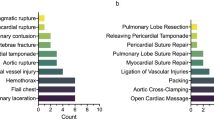Abstract
Purpose
The outcome of cardiopulmonary resuscitation (CPR) after traumatic cardiac arrest is very poor. Moreover, some consider laparotomy for abdominal trauma after CPR futile. This study aimed to investigate the outcomes of trauma patients who were pulseless and received CPR followed by laparotomy.
Method
We conducted a retrospective review of 28,255 trauma patients from our hospital from January 2009 to November 2017. Patient demographics, injury severity scores, duration of CPR, operative data, and mortality of patients with laparotomy after CPR were collected and analyzed.
Result
We identified 120 trauma patients (0.42%) who underwent CPR at admission. Twenty-three patients (0.08%) underwent laparotomy following CPR. Of these, 19 patients (82.6%) died after laparotomy. Of four survivors after laparotomy, three (13.0%) survived with a good neurologic outcome. One survivor required rehabilitation due to poor neurologic outcome. All patients had suffered a blunt injury.
Conclusion
The survival rate for laparotomy following CPR after traumatic cardiac arrest was very poor. However, laparotomy following CPR is not always futile.
Similar content being viewed by others
References
Millin MG, Galvagno SM, Khandker SR, Malki A, Bulger EM. Withholding and termination of resuscitation of adult cardiopulmonary arrest secondary to trauma: resource document to the joint NAEMSP-ACSCOT position statements. J Trauma Acute Care Surg. 2013;75(3):459–67.
Pasquale MD, Rhodes M, Cipolle MD, Hanley T, Wasser T. Defining, “dead on arrival”: impact on a level I trauma center. J Trauma. 1996;41(4):726–30.
Pickens JJ, Copass MK, Bulger EM. Trauma patients receiving CPR: predictors of survival. J Trauma. 2005;58(5):951–8.
Moriwaki Y, Sugiyama M, Yamamoto T, Tahara Y, Toyoda H, Kosuge T, et al. Outcomes from prehospital cardiac arrest in blunt trauma patients. World J Surg. 2011;35(1):34–42.
Mattox KL, Feliciano DV. Role of external cardiac compression in truncal trauma. J Trauma. 1982;22(11):934–6.
Copass MK, Oreskovich MR, Bladergroen MR, Carrico CJ. Prehospital cardiopulmonary resuscitation of the critically injured patient. Am J Surg. 1984;148(1):20–6.
Fulton RL, Voigt WJ, Hilakos AS. Confusion surrounding the treatment of traumatic cardiac arrest. J Am Coll Surg. 1995;181(3):209–14.
Burlew CC, Moore EE, Moore FA, Coimbra R, McIntyre RC Jr, Davis JW, et al. Western Trauma Association critical decisions in trauma: resuscitative thoracotomy. J Trauma Acute Care Surg. 2012;73(6):1359–63.
George RL, McGwin G Jr, Metzger J, Chaudry IH, Rue LW 3rd. The association between gender and mortality among trauma patients as modified by age. J Trauma. 2003;54(3):464–71.
MacLeod J, Lynn M, McKenney MG, Jeroukhimov I, Cohn SM. Predictors of mortality in trauma patients. The American surgeon. 2004;70(9):805–10.
Rotondo MF, Schwab CW, McGonigal MD, Phillips GR, Fruchterman TM, Kauder DR, et al. ‘Damage control’: an approach for improved survival in exsanguinating penetrating abdominal injury. J Trauma. 1993;35(3):375–82 (discussion 82-3).
Shapiro MB, Jenkins DH, Schwab CW, Rotondo MF. Damage control: collective review. J Trauma Acute Care Surg. 2000;49(5):969–78.
Endo A, Shiraishi A, Otomo Y, Tomita M, Matsui H, Murata K. Open-chest versus closed-chest cardiopulmonary resuscitation in blunt trauma: analysis of a nationwide trauma registry. Crit Care. 2017;21(1):169.
DuBose JJ, Scalea TM, Brenner M, Skiada D, Inaba K, Cannon J, et al. The AAST prospective aortic occlusion for resuscitation in trauma and acute care surgery (AORTA) registry: data on contemporary utilization and outcomes of aortic occlusion and resuscitative balloon occlusion of the aorta (REBOA). J Trauma Acute Care Surg. 2016;81(3):409–19.
Inoue J, Shiraishi A, Yoshiyuki A, Haruta K, Matsui H, Otomo Y. Resuscitative endovascular balloon occlusion of the aorta might be dangerous in patients with severe torso trauma: a propensity score analysis. J Trauma Acute Care Surg. 2016;80(4):559–66 (discussion 66-7).
Willis CD, Cameron PA, Bernard SA, Fitzgerald M. Cardiopulmonary resuscitation after traumatic cardiac arrest is not always futile. Injury. 2006;37(5):448–54.
Funding
There are no sources of funding in our study.
Author information
Authors and Affiliations
Corresponding author
Ethics declarations
Conflict of interest
Wu Seong Kang, Yun Chul Park and Young Goun Jo declare that there are no conflicts of interest.
Research involves human participants/animals
This research does not involve human participants and/or animals.
Informed consent
Informed consent obtained from subjects.
Ethical standards
The work has been approved by the appropriate ethical committees related to the institution in which it was performed.
Rights and permissions
About this article
Cite this article
Kang, W.S., Park, Y.C. & Jo, Y.G. Laparotomy following cardiopulmonary resuscitation after traumatic cardiac arrest: is it futile?. Eur J Trauma Emerg Surg 46, 657–661 (2020). https://doi.org/10.1007/s00068-019-01118-0
Received:
Accepted:
Published:
Issue Date:
DOI: https://doi.org/10.1007/s00068-019-01118-0




